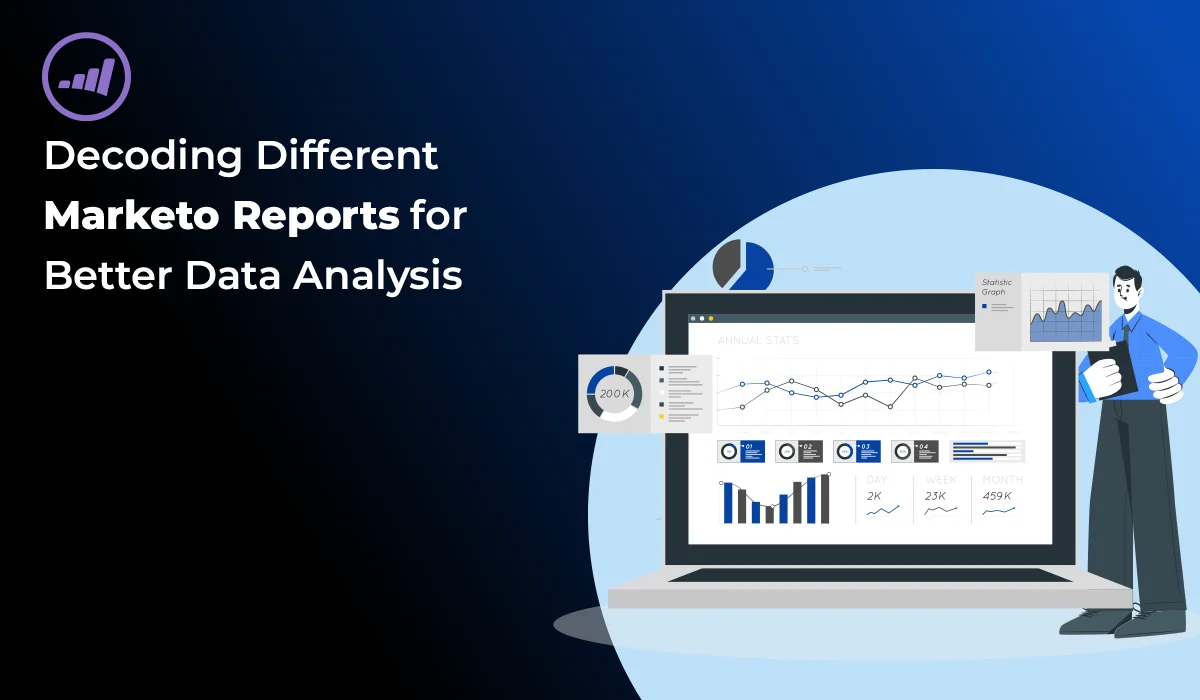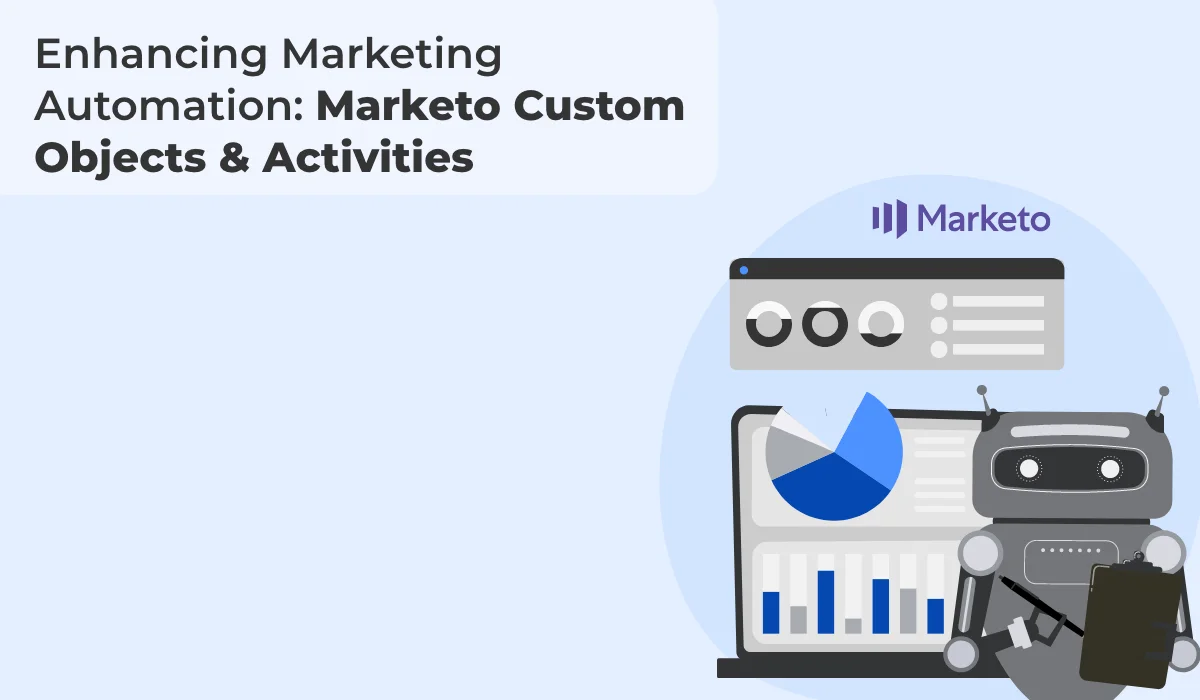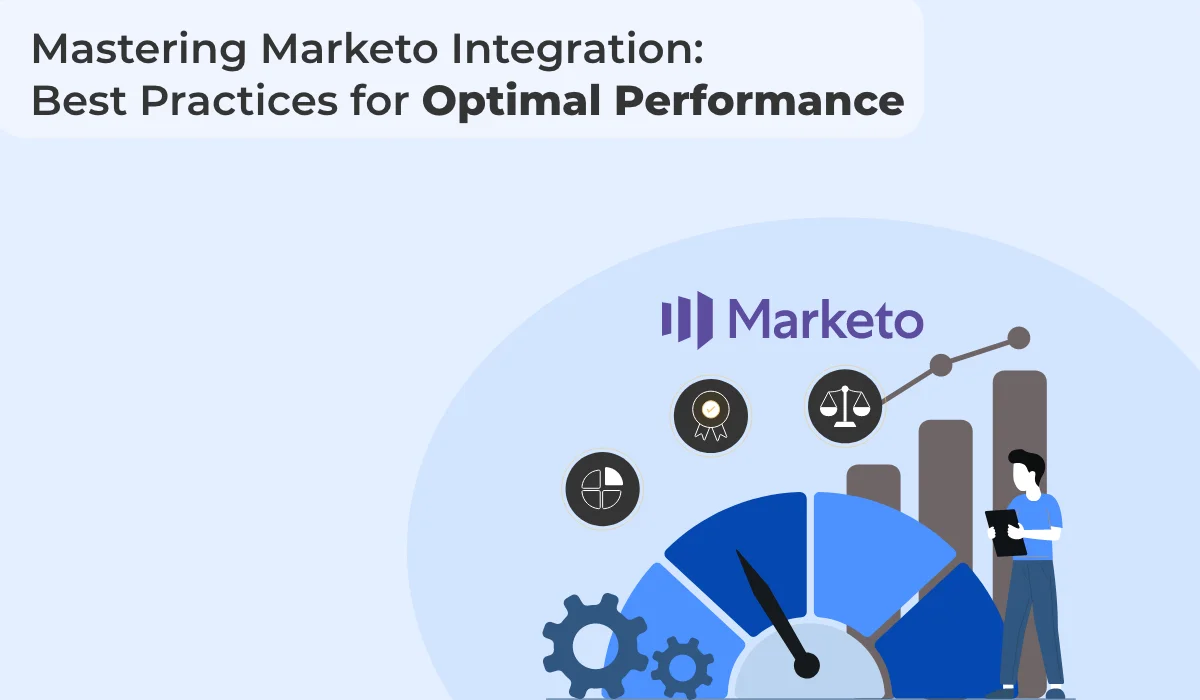Decoding Different Marketo Reports for Better Data Analysis

Published on: October 13, 2022
Updated on: July 18, 2024
681 Views
- Marketo
15 min read
Proper reporting is key to a profitable business. But that is often easier said than done, especially when using marketing automation tools such as Marketo.
Marketo offers a comprehensive reporting system with the space to generate a variety of reports. So, which one do you use and when? What is the purpose of these reports? How can you use them to provide a picture of your marketing program in a transparent, thorough, and easy-to-understand way?
In this article, we will answer these questions by looking at the different types of Marketo reports, their different use cases, and the best practices to give you a bigger bang for your buck.
Types of Marketo Reports
Marketo offers different reports to measure the performance of emails, landing pages, and web page data. Knowing which to use can help you assess engagement metrics and improve future campaigns.
Below are the different types of Marketo reports, clubbed in four broad categories:
- Tools to Measure People or Contacts
- Performance Report
- Status Report
- Revenue Stage Report
- Tools to Measure Email Campaign Performance
- Email Performance Report
- Email Link Performance Report
- Tools to Measure Email Programs and Campaigns
- Engagement Stream Performance Report
- Program Performance Report
- Tools to Measure Web Activities
- Landing Page Performance Report
- Web Page Activity Report
- Social Influence Review Report
Significance of Each Report Type in Understanding Marketing Performance
Each type of Marketo report provides specific data points that contribute to a holistic understanding of marketing performance:
- Leads and Contacts: People Reports offer insights into lead generation sources, customer acquisition, and lead nurturing effectiveness. This data helps marketers identify high-performing channels and optimize lead nurturing efforts.
- Email Campaigns: Email Reports provide crucial information on the success of email marketing campaigns, enabling marketers to gauge audience engagement and refine email content for better results.
- Email Programs and Campaigns: These reports help measure the effectiveness of entire email programs, making it easier to identify successful campaigns and areas for improvement.
- Web Activity: Web Activity Reports give a comprehensive view of website performance, highlighting which pages are driving the most traffic and conversions. Marketers can use this data to enhance website design and content.
- Revenue Attribution: Revenue Attribution Reports help marketers understand the impact of marketing efforts on revenue generation, enabling them to allocate resources strategically and maximize ROI.
- Social Media Impact: Social Media Reports provide insights into social media reach, engagement, and lead generation, helping marketers optimize their social media strategies to reach the target audience effectively.
Tools to Measure People or Contacts
Performance Report
Lead generation is essential in marketing. The number of new contacts added to the database is key to building a healthy customer base. Marketo's People Performance Report helps you track this information so that all your hard work is accurately captured and quantified.
The People Performance Report provides a summary of the total number of leads added to your database over a given period.
You can further drill down the information to get details such as:
- The number of new customers
- When these contacts were added
- The source of these leads
Equipped with such in-depth customer information, you can segment leads in multiple ways to build a more direct and effective marketing strategy. Use these reports to explore ways to connect with new contacts and enhance your marketing tasks.
Status Report
When we look at all the leads in the marketing funnel, the view is barely monolithic, with each lead falling into different stages. These stages could be ex-customer, disqualified, partner, prospect, and recycled.
People by Status Report brings the focus on each customer and their status in the various stages of the funnel. It gives you an overview of the number of leads connecting to you and their funnel stage before they convert in a specific time.
Revenue Stage Report
Each company has a different revenue cycle model that includes various stages from Anonymous to Known to Opportunity to Won.
The Revenue Stage Report summarizes where each lead is in your revenue cycle. It provides insights into which revenue stage to focus on to improve your bottom line and maximize your returns.
You can also access Revenue Cycle Analytics to get deeper insights into each revenue model. Revenue Cycle Analytics shows which initiatives are working and provides their cost to your organization so that you can use this information to recoup profits and reduce costs.
Tools to Measure Email Campaign Performance
Email Performance Report
Know the efficacy of your email marketing campaigns with Marketo's Email Performance Report. It provides a glimpse into your existing subscribers and their interaction with your emails.
Email Performance Report takes all the guesswork out of email marketing with its ability to evaluate and simplify the detailed statistics behind your email campaigns. This includes all types of metrics such as the number of clicked emails, opened emails, soft bounced rate, and delivered emails.
You can also find out the status and progress of your email campaigns.
Email Link Performance Report
The first rule of email marketing is never to send an email without a link. The link can be a simple call-to-action like "sign up" or "click here," social media share or follow, etc.
Email Link Performance Report, as the name suggests, measures the impact of these links in your marketing campaigns. It tells you:
- The total number of times a link was clicked.
- The total number of unique subscribers who clicked and visited the landing page.
When you know which links are working and which are not, you can tweak them to increase the efficacy of these email links. Use some of the Marketo recommended best practices for links in emails to increase your click-through rate.
Tools to Measure Email Programs and Campaigns
Engagement Stream Performance Report
Marketo is primarily an email automation tool that supports multiple marketing campaigns such as onboarding, webinars, nurturing, or welcome emails. These email campaigns are designed for specific stages of a contact's journey with your company. Use the Engagement Stream Performance Report to get a unified overview of all these email campaigns in a single dashboard.
The report provides the engagement score for any selected email campaign using Marketo's proprietary algorithm. This score accounts for engaged (Open, Click, Program Success) and disengaged (Unsubscribe) behavior, with 50 as the neutral score. Anything above 50 is considered above average, while below 50 is considered below average engagement score.
Program Performance Report
The Program Performance Report gives an overview of the performance of all ongoing Marketo campaigns, including webinars, seminars, and user groups. Though the details in this report are minimal, you still get a good idea about the progress of every program in a single report.
The report covers details such as the number of contacts in a program, those who have attained the defined success step, new members acquired, and the program's total costs.
Tools to Measure Web Activities
Landing Page Performance Report
In times of digital marketing, there is no escaping the landing page. Landing pages generate leads using form to gather details such as names and email addresses. There are other click-through landing pages, which directly ask visitors to purchase or subscribe.
Even though landing pages constitute only 6.1% of all the signup forms, they have the highest conversion rate. And that is why you need a rock-solid strategy for it.
Maximize conversion rate by using Landing Page Performance Report, which offers details such as the number of people who filled out the form or interacted with the page. The report offers insight into the design and execution of the page as well as into ways to maximize traffic and conversion.
Web Page Activity Report
A large part of your digital marketing strategy should revolve around your company's web page. It is the digital equivalent of your business store.
Use the Web Page Activity report to enhance your web page's ROI and lead generation. This report helps analyze details of your web visitors and subscribers, including the overall performance of your website, pages with the highest traffic, links with maximum clicks, and other important metrics.
Social Influence Review Report
The Social Influence Review Report tracks all your social media-related activity of targeted customers and their sharing of social media profiles. This report is created in the Marketo social suite with use/add social buttons.
For instance, when you put your social media buttons from Marketo into a newsletter page, it shows how many people shared it through each channel and the number of unique leads generated.
Key Marketo Report Metrics
Marketo reports offer a wealth of valuable data and metrics that play a pivotal role in understanding marketing performance. Here are the essential metrics found in Marketo reports, categorized by different aspects of marketing:
1. Lead Generation and Conversion Metrics
- Leads Generated: This metric represents the total number of new leads or contacts acquired during a specific period. It helps assess the success of lead generation efforts and identify the most effective lead sources.
- Conversion Rate: The conversion rate measures the percentage of leads that successfully convert into customers or achieve a specific goal like form submission, or trial sign-up. A higher conversion rate indicates the efficiency of the marketing funnel.
- Cost per Lead: Calculated by dividing the total marketing expenses by the number of leads generated, the cost per lead metric gauges the overall effectiveness and efficiency of lead generation campaigns.
2. Email Marketing Performance Metrics
- Open Rate: The open rate indicates the percentage of recipients who opened an email campaign. It reflects the effectiveness of the email subject line and helps optimize email content.
- Click-Through Rate (CTR): CTR measures the percentage of recipients who clicked on a link within the email. It indicates how engaging the email content is and how well the call-to-action resonates with the audience.
- Bounce Rate: The bounce rate represents the percentage of emails that were not delivered to the recipient's inboxes due to invalid addresses or other issues. A high bounce rate may indicate the need for better list hygiene.
- Unsubscribe Rate: Unsubscribe rate shows the percentage of recipients who chose to opt out from further email communications. It's essential to monitor this metric to refine email content and frequency.
3. Website and Landing Page Metrics
- Page Views: Page views indicate the total number of times a web page or landing page has been viewed. This metric helps identify popular content and assess website traffic.
- Unique Visitors: Unique visitors represent the number of distinct individuals who visited the website or landing page. It helps determine the size of the audience reached.
- Bounce Rate: The bounce rate for a website or landing page shows the percentage of visitors who leave without interacting further with the site. A lower bounce rate indicates engaging content and a positive user experience.
- Conversion Rate: The conversion rate for landing pages measures the percentage of visitors who completed a desired action, such as filling out a form or making a purchase.
4. Revenue Attribution Metrics
- First-Touch Attribution: This metric attributes revenue to the first touchpoint or marketing interaction that initiated a customer's journey. It helps identify the most effective channels for lead generation.
- Multi-Touch Attribution: Multi-touch attribution distributes revenue across multiple marketing touchpoints, acknowledging the various interactions that contributed to a customer's conversion. This provides a more holistic view of the customer journey.
5. Campaign Performance Metrics
- Cost per Lead: In the context of campaigns, this metric reveals the cost of acquiring a lead through a specific marketing campaign. It enables marketers to evaluate campaign efficiency.
- Conversion Rate: Campaign conversion rate reflects the percentage of leads that successfully convert into customers or reach a specific campaign goal.
- Return on Investment (ROI): ROI measures the revenue generated compared to the cost of running a marketing campaign. It indicates the campaign's overall profitability and success.
Common Pitfalls in Interpreting Marketo Reports
Interpreting Marketo reports is a crucial aspect of data-driven decision-making, but it's not without its challenges.
Here are some common pitfalls that marketers should be aware of when analyzing Marketo reports:
Misinterpreting Metrics in Isolation
One of the most common mistakes is viewing individual metrics in isolation without considering the broader context. For example, focusing solely on high email open rates may overlook low click-through rates, leading to an incomplete understanding of the campaign's effectiveness.
Lack of Benchmarking
Not having benchmark data to compare performance can lead to a skewed perspective. Without a point of reference, marketers may struggle to assess whether their metrics are above or below industry standards.
Ignoring Data Quality Issues
Inaccurate or incomplete data can significantly impact the reliability of Marketo reports. Ignoring data quality issues, such as duplicate or outdated records, can lead to erroneous conclusions and ineffective decision-making.
Overlooking Multi-Touch Attribution
Attribution models that only credit the last touchpoint before conversion may undervalue the contribution of other marketing efforts throughout the customer journey. Overlooking multi-touch attribution can lead to misallocation of resources.
Failing to Define Clear Goals
Without well-defined goals for marketing campaigns, it becomes challenging to determine whether the performance meets expectations. Setting clear objectives is essential for effective data analysis.
Marketo Reports Best Practices
A tool is beneficial only when its user knows how to wield it well. This statement rings true for Marketo reports too.
When you are clear about your requirements from a tool such as Marketo, then only you can see its massive impact on your bottom line. Here are the top three best practices when using Marketo reports.
Define the Purpose
Develop a blueprint of questions that need to be answered when you plan for a report. In other words, define the purpose. Why do you need the report; what are the metrics you want to measure; and what are you hoping to achieve from it?
These questions will then serve as the spine for customization. Otherwise, you will end up clubbing different reports together in your hunt for dimensions and metrics.
For instance, if your goal is to determine the overall database growth for a given period, then go to the People Performance Report and its different filters. See which tactics worked and which did not to make necessary changes based on the performance and your targets.
Know Your Tools
Consistent, clean data gathering is essential while creating a report. Tools like Marketo are specially designed for this purpose. You need to know the basics – what kind of reports are available and what fields are included in each. With a range of reports available, you can familiarize yourself with each of these reports through training, consultations, and product documentation.
Marketo provides certification to users to familiarize themselves with the tool and maximize its adoption. As your familiarity with Marketo grows, you can develop your system to make it reporting-friendly. For instance, you can use tags to filter information such as customer name, region, channel, etc., or effectively utilize the "drill down" option.
Interpret Data Correctly
With a blueprint of questions in hand, you will be indirectly creating a design for your report. That's great. But generating the report is only half the job. You need to interpret it accurately to tell the story.
For instance, your report highlights a 10% email open rate or a 1% unsubscribe rate. Is that good or bad? Do you need to optimize your subject line further?
The answers to these and similar questions depend on factors like your data quality, industry, and company benchmarks. Data interpretation from these reports can make or break your marketing campaigns and directly impact the bottom line.
Explore Emerging Trends and Advancements in Marketing Analytics and Reporting
In the ever-evolving marketing landscape, Marketo is at the forefront of adapting to emerging trends in analytics and reporting. Among these trends are Artificial Intelligence (AI) and Predictive Analytics, empowering marketers with deeper insights from Marketo data to predict customer behavior, automate campaign optimizations, and personalize marketing efforts.
- Cross-channel reporting integrates data from various sources, offering a unified view of the customer journey and campaign performance.
- Real-time reporting gains significance for agile decision-making, enabling marketers to access up-to-the-minute data and optimize campaigns promptly.
- Enhanced data visualization capabilities equip marketers with more interactive and customizable visualizations, facilitating quick insights and effective communication with stakeholders.
Marketo consistently updates its features to align with these trends. Expect AI-driven features, and predictive analytics for better targeting, and personalization. Real-time reporting capabilities will be enhanced, enabling monitoring of campaign performance and customer interactions in real time. Marketo may invest in advanced data visualization tools to present data more effectively and support dynamic decision-making.
It’s important to remain competitive in today's marketing landscape and stay updated with evolving reporting practices. Regularly explore new Marketo features, attend webinars, and continuously learn to harness the full potential of Marketo reports.
Thus, make confident data-driven decisions, and achieve greater marketing success.
Conclusion
Marketing in the digital age has become a nimble-footed game of metrics and figures laid out in business reports. Marketo reports aid in making sure your business is not left behind. With its different reports addressing your various business needs, Marketo will amp your marketing game and lead your business into an ROI-bright future. Still not sure where to start? Let Growth Natives help. Our Marketo experts can help you create customized reports based on your business needs. Contact us today at info@growthnatives.com!
Frequently Asked Questions
Understanding Marketo reports is crucial for analyzing marketing data, measuring the effectiveness of marketing campaigns, identifying areas for improvement, and making data-driven decisions to enhance marketing strategies.
Reports in Marketo can be accessed through the Analytics section. Users can create, customize, and save reports based on their specific needs and preferences.
An Email Performance Report provides insights into the performance of email campaigns, including metrics such as open rates, click-through rates, bounce rates, and unsubscribe rates. This report helps evaluate the effectiveness of email content and delivery.
Revenue Cycle Analytics (RCA) is a set of advanced reporting tools in Marketo that help analyze the entire revenue cycle, from lead generation to closed sales. RCA provides insights into lead conversion rates, pipeline velocity, and revenue attribution.
Common challenges include data accuracy, understanding complex metrics, integrating with other systems, and making sense of large volumes of data. Address these challenges by ensuring data quality, continuous learning, and leveraging Marketo’s support resources.
To make actionable decisions, focus on key metrics that align with your business goals, identify trends and patterns, look for areas of improvement, and use insights to adjust your marketing tactics. Setting benchmarks and comparing data over time can also help in making informed decisions.
Best practices for analyzing Marketo reports include setting clear objectives, regularly reviewing key metrics, segmenting data for more granular insights, comparing performance over time, and using the data to inform and adjust marketing strategies.



